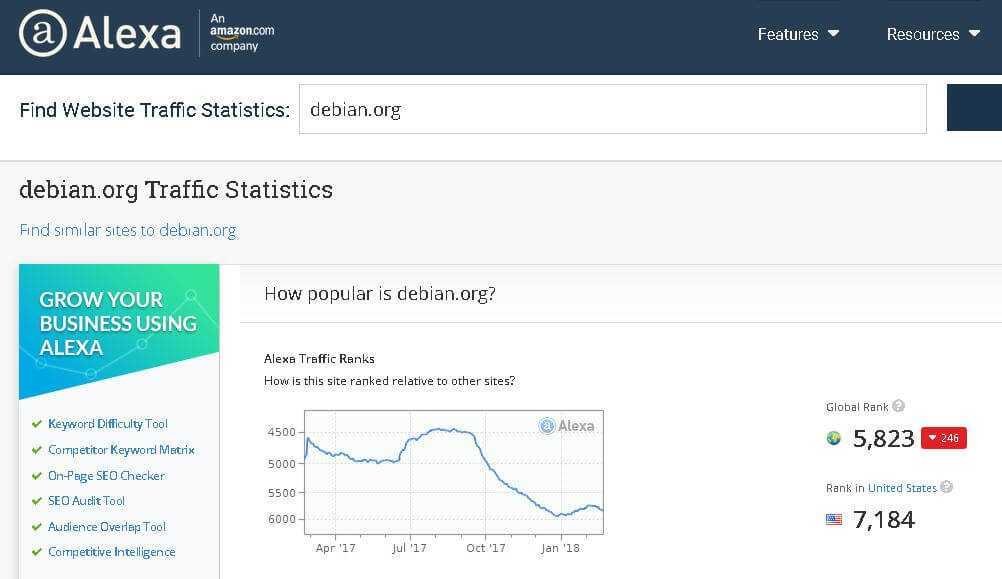Manjaro first on Distrowatch visits: Because I deal a lot with Linux, I often visit the Distrowatch page. The page is an online directory of Linux distributions. So you can look for the distribution that interests you and find out if it meets your needs. The website is updated daily with new versions of distributions and open source applications.

Hit Ranking now using Distrowatch is a method of evaluating interest in the distributions hosted on the website. Essentially, the service counts the clicks that each distribution receives, highlighting those that interest most users.
This feature of the page has at times become the bone of contention between major distros vying for the top spots, as it is nothing more than a click counter of each distro's page. The page displays data per year, month, 30 days, week, etc.
While there are many who consider DistroWatch as a non-objective source for the popularity of Linux projects, one that can not be denied is the age and completeness of the site. The page has been addressed to Linux friends for years, has almost every release that has been released and adds to any new distribution that is being distributed by developers.
This means that the majority of clicks come from Linux geeks, so the ranks are probably not so unrepresentative.
So I'm not referring to Hit Ranking as a reliable method of evaluating each distribution, but more as a "counter" of traffic to a page that only deals with Linux.
If you are trying to find other ranking results, a good source is Alexa.
But let's look at what has emerged in Distrowatch lately. For a very long time (since 2011) the Mint distribution holds the first place in the DW Hit Ranking. But for some time now, Manjaro, an Arch Linux fork, has continued to rise in the rankings. So since yesterday for the first time the distribution managed to pass the Mint:

So overall results for the last 6 months 2017-2018 are as follows:
 Note that 8 of the 12 distributions are LTS (long-term support), and 1 of the 12 has (and) Rolling Release, i.e. rolling edition. Of course we are talking about openSUSE Tumbleweed. Two of the 12 have only Rolling Releases (Manjaro and Antergos). The Solus distribution is semi-rolling and the Fedora distribution which is a cutting edge distribution but is not rolling.
Note that 8 of the 12 distributions are LTS (long-term support), and 1 of the 12 has (and) Rolling Release, i.e. rolling edition. Of course we are talking about openSUSE Tumbleweed. Two of the 12 have only Rolling Releases (Manjaro and Antergos). The Solus distribution is semi-rolling and the Fedora distribution which is a cutting edge distribution but is not rolling.
OpenSUSE also has a LTS version called Leap.
Finally the TrueOS distribution is based on FreeBSD (Unix).
But let's talk about Manjaro.
For those who do not know the operating system, Manjaro is based on Arch Linux and its goal is to make things easier for novice Linux users.
Manjaro's installation is simple and can be done with two different graphical applications but also traditional via the terminal.
In general, Manjaro Linux deserves your attention and leaves a lot of promise for the future.
The myth we found while working with distribution is that rolling releases can be stable and offer reliability.
Manjaro Linux automates many processes that you have to do manually in Arch, which makes distribution quite affordable even for novice users.
This of course has not gone unnoticed by Linux friends, as we see in the Distrowatch ranking the distribution has now reached second place, chasing Mint Linux, which has long been at the top.
But let's look at the rank that Alexa gives. This rank now concerns the global ranking of the website of each project, and is a method used as a metric traffic system. So we can talk about metrics that show the popularity of a website in relation to the rest globally, and no longer among geeks.
So in the pictures below you can see Alexa ranking in the distributions that are first in the Distrowatch ranking: Debian, Manjato and Mint.



The ranking is very different, with Mint clearly ahead of Debian and Manjaro. On the other hand, we notice a decrease in the traffic of the Debian page (pay attention to the graphic), but also the return of traffic to the Manjaro page.
The drop in Debian traffic does not mean that the distribution has ceased to be the favorite of the majority, as this distribution is used as a basis by many other top distributions (Ubuntu, Mint, MX Linux, antiX, Sparky and many others)
In view of all the above, it is probably safe to say that the Mint is rightfully maintaining the first place in the world, and that the Manjaro seems to be preferred by the geeks, as it seems to be rising in the special ranking of the Distrowatch.
The rise of Manjaro in the Distrowatch list, compared to other stable distributions (Ubuntu, Debian, elementary) shows a tendency to adopt the rolling operating system.
Rolling distributions offer software and new ones from time to time updates cutting edge systems i.e. the latest updated version that is released.
Debian again has not stopped occupying the interested parties with its stability, although many times it is "served" with many different brand names.
- TOP500 Supercomputer: Linux 500 on 500 computers
- Linux what you need to know before adopting the operating system





